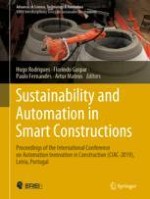2021 | OriginalPaper | Chapter
NZEB Modular Prefabricated Building System
Energy Analysis
Authors : Armando Pinto, Rafaela Mateus, Jaime Silva, Miguel Lopes
Published in: Sustainability and Automation in Smart Constructions
Publisher: Springer International Publishing
Activate our intelligent search to find suitable subject content or patents.
Select sections of text to find matching patents with Artificial Intelligence. powered by
Select sections of text to find additional relevant content using AI-assisted search. powered by
